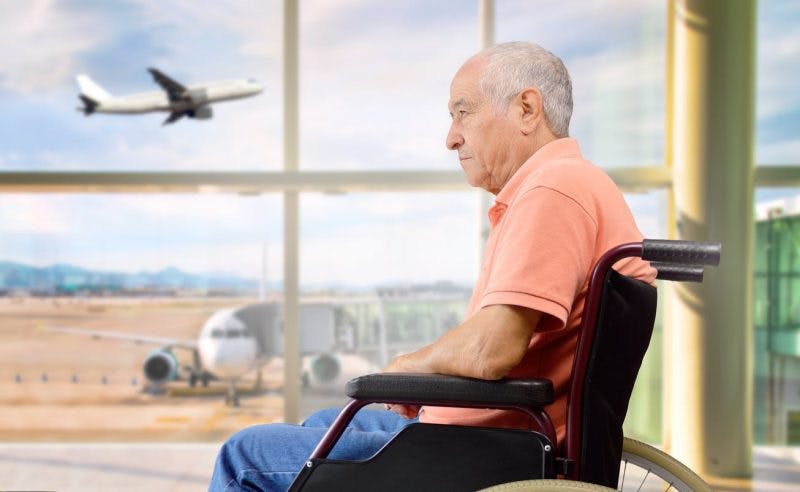Flying after stroke is a common concern for many stroke survivors – and for good reason. A stroke is a serious medical event that can lead to lasting effects on mobility, physical function, and overall confidence. A stroke also increases the risk of a second or recurrent stroke.
As a result, stroke survivors may have concerns about air travel in the future and questions about flying after stroke such as: How long after a stroke can I fly? What medical conditions make flying unsafe? Does flying increase my risk of another stroke, and what happens in the worst-case scenario?
These are all valid questions for anyone hoping to fly after a stroke. Luckily, stroke survivors can follow general guidelines to fly safely and feel more at ease. To help you prepare for travel, this article will review these guidelines for flying after a stroke. In addition, we will cover some helpful tips and tricks to make your journey as stress-free as possible.
Guidelines for Flying After Stroke
Stroke survivors often ask, how soon is it safe to fly after a stroke? According to the Stroke Association, it is best to wait at least two weeks to fly following a stroke. This is because a person is at an increased risk of a second stroke after suffering a TIA (transient ischemic attack) or mini stroke.
In the event of a second stroke, it is advisable to be close to emergency medical interventions that can reverse the stroke effects, such as the administration of medications like TPA. Another reason doctors may recommend delaying air travel is that new post-stroke medical conditions can sometimes develop within the first few months after the stroke.
In this case, it is best to be near your medical providers to receive medical attention if needed.
Ultimately, every stroke is different, so getting clearance from your doctor before you fly is important. They can determine if you are medically stable enough to participate in air travel. Otherwise, it’s best to remain near home, where medical attention is quickly and easily accessible. If your travel plans are flexible, waiting 1-3 months to travel after a stroke is best.
Risks to Consider Before Flying After Stroke
By understanding the risks of flying after a stroke, you can have an informed discussion with your doctor about when it’s safe to fly again. Here are some complications that can accompany flying after stroke.
Hypercoagulability (Excessive Blood Clotting)
Hypercoagulability is an increased tendency for your blood to form clots. Flying increases your body’s tendency to form clots. These clots are the cause of ischemic stroke which takes place when an artery in the brain becomes blocked by a blood clot.
Several research studies show that air travel can increase the risk of developing a blood clot, both during and after the flight. In fact, long flights can elevate clot risk by 26%.
Inactivity in cramped spaces on flights can lead to blood clots developing in the legs. A deep vein thrombosis (DVT) is an example of this and occurs when a blood clot forms in the leg. Small pieces of this clot can also break loose and travel to clog an artery in the lungs, causing a life-threatening condition called pulmonary embolism, or it can travel to the brain, causing a stroke.
Reduced Oxygen Levels
The air pressure is lower on a plane, which means less oxygen is available to fuel your body, including the brain. During stroke recovery, oxygen is critical for recovery (see: oxygen therapy for stroke), so it’s best to avoid sitting in an environment with less oxygen for prolonged periods of time.
Although reduced oxygen levels while flying are unlikely to pose a risk for survivors of stroke, this can be an issue for those with comorbidities such as breathing difficulties or a heart condition. Again, it is best to speak with your doctor to determine if flying is a safe option for you.
Delayed Medical Treatment
If you experience a stroke on a plane, the pilot may initiate an emergency landing to get you immediate medical attention. While emergency landings have saved lives, limited medical resources and delayed response times during a flight can still hinder timely treatment.
In addition, some stroke interventions, such as administering TPA (tissue plasminogen activator), require immediate action to be effective
Overall, the incidence of stroke while flying is low, but it is still important to exercise caution and follow the advice of your medical team. Now that we have reviewed the flying risks, let’s discuss how to make your trip as safe as possible if you decide to fly after stroke.
Tips for Flying After Stroke
Although travel is exciting and creates new opportunities, it can be stressful or overwhelming at times. This may be especially true for survivors of stroke, especially if you’ve experienced changes in mobility or are concerned about the risks of flying.
However, there are many things you can do when flying to help decrease the risk of developing a clot and reduce travel stress. Once your doctor clears you to fly after a stroke, follow these tips to stay safe and support your well-being during travel:
General Guidelines for Flying After Stroke
- Contact the airline to arrange special assistance (72 hours to one week in advance). This may include vision assistance, hearing assistance, wheelchair service, and mobility and medical device transport. Additionally, you can request transportation assistance at designated airport assistance points if you have limited mobility.
- Travel with a companion if possible so that someone can assist you if you need help. This can give you peace of mind when traveling, especially your first time flying after a stroke.
- Get travel insurance. Purchase travel insurance to protect your trip. It helps you avoid issues if you need to refund or reschedule your flights or other travel plans. Additionally, medical care abroad can be costly. Check how your health insurance covers you at your destination before you travel.
- Give yourself an extra hour to get through security and walk to your terminal. This ensures you have time to check or transport all necessary baggage and equipment without additional stress. It is also important to allow yourself sufficient time to rest when creating your travel itinerary.
- Keep medication in your carry-on bag so it is easily available. Keep your medication in your carry-on bag to avoid losing access if the airline misplaces your checked luggage. Additionally, make sure you bring enough medication to last your entire trip.
- Carry medical documentation and declare medication upon arrival in a new country. Some countries may confiscate undeclared medication, so make sure you know your destination’s specific requirements before leaving.
- Wear compression socks as they are excellent at improving circulation in your legs and preventing blood clots from forming. Be sure your compression socks have adequate compression and are at least knee-high in length. Compression levels range from 7mmHg to 50 mmHg pressure. Check your garment and choose a stocking that is closer to 20-30mmHg for the best compression.
- Walk around. When it’s safe, get up and walk around. Movement helps prevent blood clots during long flights. If you cannot walk around due to turbulence or other reasons, perform leg exercises while seated (march in place, extend your knees, pump ankles, etc.)
- Be mindful of what you eat and drink. This can have a direct effect on blood pressure, which is an important stroke risk factor. Staying hydrated and avoiding excessive salty snacks can help you feel better and avoid elevated blood pressure.
Can You Fly After Stroke?
All stroke survivors face a risk of recurrence, but flying can increase that risk. This is especially true within the first 6 to 12 months so consider plans carefully during this time. Overall, it’s up to your doctor to decide if and when it is safe for you to fly after a stroke. Everyone has different risk factors and medical complications that may require a greater waiting period before flying.
Once your doctor gives you medical clearance, prepare for travel by reviewing airline and destination guidelines related to your health status and medications. Take precautions like wearing compression stockings, moving frequently, and allowing for additional time to reach your gate. These give you peace of mind so you can enjoy your trip.
We hope this article has helped educate you on the risks of flying after a stroke, the importance of consulting your medical team, and different tips to help keep you safe during travel. Your health is the most important factor, so exercise good judgment and enjoy your travels.










